Imagine your network of supporters reaching out on your behalf, raising funds to support your cause, and expanding your reach into new circles. They’re telling your story, raising awareness, and getting their own networks excited about your cause. It’s a pretty picture, but how do you make it happen?

Peer-to-peer fundraising accomplishes these things, but sometimes it’s hard to know where to begin. It’s overwhelming, and when we’re overwhelmed, it’s tempting to scrap it all and go back to doing what we’ve always done.
At CauseVox, we believe that the benefits of peer-to-peer fundraising are too great to ignore, and we’re here to help you run a peer-to-peer fundraising campaign that empowers your supporters, engages your community, reaches new donors, and raises more money for your cause.
Download your peer-to-peer fundraising planning guide below
[amp-optin id=24994]
What’s So Wonderful About Peer-to-Peer Fundraising?
Peer-to-peer fundraising relies on the power of community, and makes fundraising a very personal, human experience. It transforms your network of supporters into an army of fundraisers, each reaching out to their own networks, sharing your cause. Organizations large and small can reap the benefits of a peer-to-peer campaign, including:
- New supporters
- Deeper relationships with existing supporters
- Increasing your reach quickly
- Freeing up time for fundraising activities only you can do
Instead of the longer, more traditional process of building donor relationships, peer-to-peer fundraising takes advantage of relationships that already exist, making it faster and friendlier.
CauseVox’s peer-to-peer fundraising platform includes:
- Empowering your supporters by making it simple for them to create personal or team fundraising pages
- Easily integrating with social media to be quickly shareable
- Streamlining administrative tasks, like reporting and receipting, so you can spend more time doing people-based tasks, like communicating with your donors
“Peer-to-peer fundraising relies on community, and makes fundraising a very personal, human experience.” tweet this
Is Peer-to-Peer Fundraising Right For My Organization?
Before you dive into peer-to-peer fundraising, it’s important to ask yourself a few questions:
1. Do we have a mission-supporting story to tell with this fundraising campaign? Successful peer-to-peer campaigns tell a specific story that supports the mission of the organization. In general, fundraising campaigns that focus on a particular project, rather than operational support, tend to do better.Project Renewal has many programs to help people struggling with homelessness in NYC.
For their En Casa fundraising campaign, they focused only on housing for families. Then, for their fundraising story, they zeroed in on the story of one woman and her family for a powerful impact.
2. Do we have a network of supporters who are enthusiastic about becoming ambassadors?
You don’t need a million supporters for a successful peer-to-peer campaign, but it does require at least a small crowd to get going. Ask yourself who you can realistically expect to participate. Don’t despair if there’s only a handful of people–a few passionate supporters can do a lot.
3. Do we have time and resources to invest in making our peer-to-peer campaign successful?
Peer-to-peer fundraising takes a lot of the on-the-ground fundraising work off a nonprofit, but the campaign does still require time and effort to manage. Make sure you’re accounting for monetary costs, like the use of a fundraising platform and creating a fundraising video, as well as the cost of your staff’s time. Peer-to-peer fundraising is a great way to expand your network and raise more funds, but it’s not magic.
“Peer-to-peer fundraising takes a lot of the on-the-ground fundraising work off a nonprofit…” tweet this
Long Before “Live”: Pre-Planning Your Campaign
A camping trip doesn’t start when you pitch your tent, and a peer-to-peer fundraising campaign doesn’t begin when you launch your online fundraising platform. Successful camping requires thinking ahead and planning in advance, and your campaign is no different.

While you won’t need to pack a cooler, or figure out how to bear-proof your campaign, you will need to do a fair amount of thinking and discussion. The result of this work will be a solid plan that you can use throughout your campaign.
Pre-Planning Questions
- What do we want to do?
This is the heart of your campaign–what, exactly, are you raising money for? The more specific you are, the better. - How much money are we trying to raise?
What does it cost to do the good thing you want to do? How much of that do you want to raise through your peer-to-peer fundraising campaign? Your goal should be SMART–specific, measurable, attainable, relevant, and time-based.Specificity helped Allies Against Slavery plan a successful $30,000 campaign with CauseVox.“While we’ve done campaigns in the past, this time around we were more thoughtful about the content and created a fundraising campaign for specific program, with a very specific ask and theme,” said Torey Tipton, Associate Director of Key Relationships and Impact. - What are our other goals?
While your money goal will demand most of your focus, there are other benefits to a peer-to-peer fundraising campaign that are worth tracking and setting goals for, like the numbers of new donors and supporters who raise funds for you, and how often your campaign is shared on social media or in the press. - Who is in charge of this thing?
Decide on roles, responsibilities, and ownership of each aspect of the campaign.
Pre-Planning Activities
Recruit Your Tribe
Identify and make contact with potential peer-to-peer fundraisers among your supporters. Invite them to participate in the campaign, and start building excitement.
Set The Stage
Choose an online fundraising platform with peer-to-peer features like personal and team pages. Make sure it’s easy to work with, and customizable for your needs. CauseVox’s all-in-one fundraising platform features easy design for non-techies, personal and team pages, secure and simple donation processing, and dedicated customer service.
Making a donation should be very simple. The last thing you want is for someone who is ready and excited to make a donation to be unable to do so because your fundraising platform is confusing.
Customer Michelle Hoeft of BeLoved Atlanta values how is how simple donation processing with CauseVox is. “One of the things we were really excited to use is Stripe for donation processing because of the simplicity and seamlessness! Donors were really easily able to make donations to the campaign without getting confused.” Once you’ve got your platform, it’s time to focus on storytelling, particularly the kind you have to do ahead of time, like making a fundraising video.
Plan Your Timeline
Get out your calendar, and start looking at dates. It may be helpful to work backwards and start by choosing an end date for your campaign. Then, decide how many days you want your campaign to last to determine when to launch.
As a general rule, longer is not necessarily better. You want to give donors a sense of urgency, and a drawn out campaign can inhibit that. Once you’ve got your basic dates worked out, it’s time to plan your communications. What kind of content do you want to share, and when will you share it? How often will you contact your supporters? When will you post on social media? Who is responsible for each of these items? Plan it out!
You won’t be the only one communicating your message–your peer-to-peer fundraisers will be telling their networks all about it. To help them do it effectively, create a promotional toolkit to promote the campaign. A toolkit is a collection of useful resources, graphics, tips, and templates to share your message.
Launch Time!
You’ve got your video uploaded, your fundraising platform ready, and your supporters excited…time to launch!
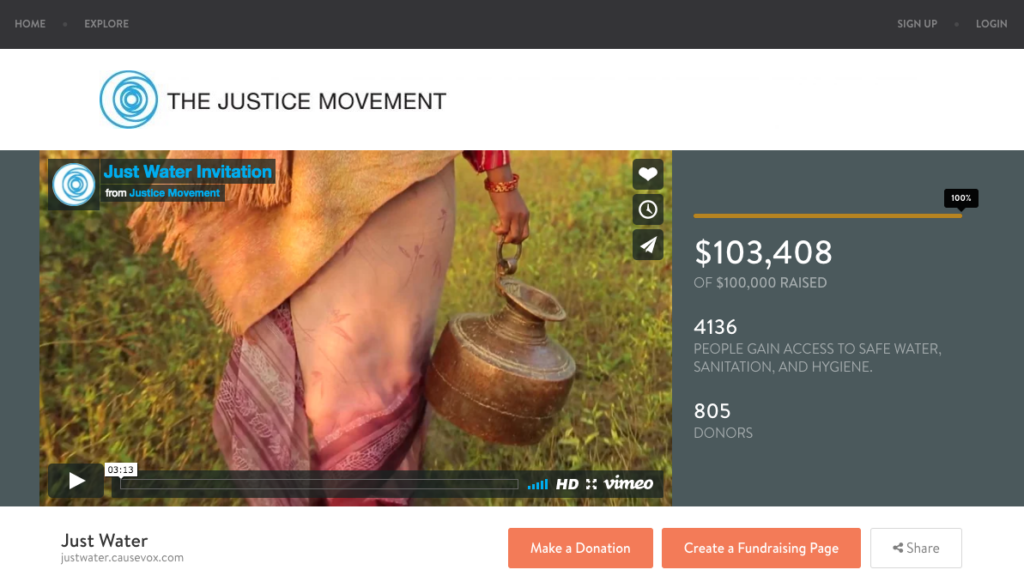
On Launch Day
The first day of your peer-to-peer fundraising campaign is exciting. You’re bringing your message to the world, and your supporters are starting to make contact with their networks. Support a great first day with:
- Clear Communication
Whatever your story, you’ll want to follow this very simple outline to tell it:
- Easy Sharing Options
There’s a reason CauseVox websites feature social media sharing so prominently–the easier something is to share, the more people will do it.
As The Campaign Goes On
If you’re doing a one-day fundraising event like GivingTuesday, you’ll launch, run, and end your campaign all in the same day. For campaigns that last a little longer, how you handle the long haul can make or break success.
Top Priorities During Your Campaign
1. Keep The Momentum Going
A peer-to-peer fundraising campaign is not a “set it and forget it” kind of enterprise. Once you’ve launched, you’ll need to reiterating your message by sending out regular updates on all your communication channels.
Jennifer Johnson of Advocates, saw the value of persistence while raising $13,000 during a holiday drive. “Be persistent – don’t give up. As long as the asks are impactful, authentic, and engaging, you will reach your supporters and they will respond. Balance your content with direct asks, demonstrations of impact, and celebrating and thanking supporters for successes.”
CauseVox makes this easy to do on your fundraising platform. Your updates will continue your storytelling, and continue to engage your supporters.

2. Monitor Your Campaign
The only way to know how your campaign is going is to keep an eye on how it’s going. Part of the “all-in-one” of CauseVox’s all-in-one fundraising platform is the built-in administrative interface that makes it easy to keep track of your campaign. Watching the details is how you course-correct and know if you’re progressing toward your goal.
3. Support Your Supporters
Check in with your peer-fundraising supporters, and make sure everything is going smoothly for them. Be sure to thank and congratulate them for the great job they’re doing on your behalf.
4. Connect With New Donors
Ideally, once new donors learn about your good cause and fantastic organization, they will want to continue to support you. The difference between someone making a one time donation and becoming a regular contributor is the depth of the connection you make with them. Deepen your connection by thanking them promptly and communicating with them regularly.
We make thanking donors simple.“The immediate acknowledgement of donors on the campaign page, along with the ability to leave comments, is a great way for donors to feel recognized, appreciated, and truly a part of the campaign,” said Jennifer Johnson.
Power Up With Partnerships
Peer-to-peer interactions are the most important part of your campaign, but other kinds of teamwork can supercharge your campaign’s impact. Partnerships with other organizations, including businesses and nonprofits expand your reach into their networks and pool your resources.
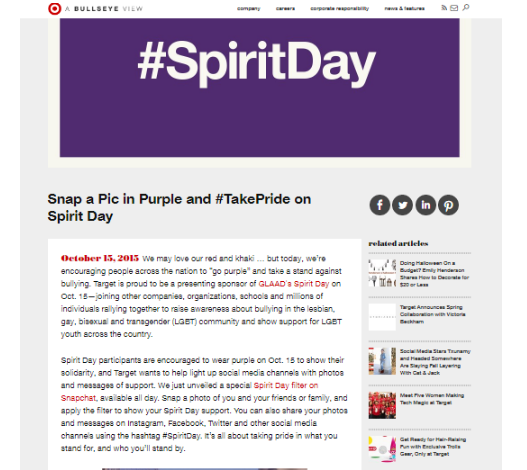
Teaming up with a major donor, whether corporate or individual, gives you the opportunity to attract attention with matching or challenge gifts. These gifts can have a significant results–revenue goes up 19% just at the mention of an available match, and an individual becomes 22% more likely to give if a match is offered.
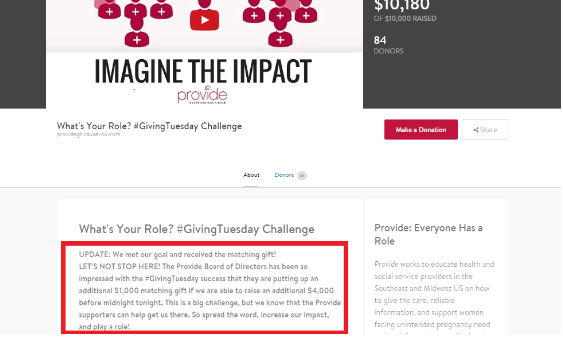
Wrapping Everything Up
Woo! You did it! Your first peer-to-peer fundraising campaign is over, done, finished! There’s still some final work to do, though. As your campaign comes to a close you’ll want to wrap it up effectively and set the stage for your next one. Top items for your end-of campaign checklist include:
- Stay Strong All The Way Through.
It’s not over until it’s over, so keep updating and sharing your campaign until the very end. Don’t underestimate the power of a last-minute push to get to your goal. - Thank everyone. Thank them again.
Even if you send an automatic “thank you” email after every donation, take the time at the end of the campaign to thank your donors again. Emphasize the impact they’ve made, and the change that can happen because of their support. - Tell everyone how it went.
Update your supporters on the final total. They want to know how it went. - Show the donated money at work.
Once you start using the donations, show the donors what you’re doing. They want to see the concrete effects of their donation. - Recognize your supporters.
Peer-to-peer fundraising does not work without your network of supporters pitching in. Whether it’s a special thank you, a social media shout-out, or a formal commendation, recognize the time and effort they gave your cause.
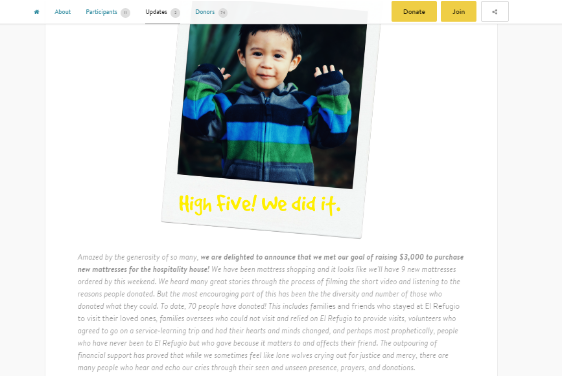
Goals, Goals, Goals
What if you don’t make your goal?
Missing a goal is disappointing, no doubt, but it’s also an opportunity to learn what will be more effective next time around. Using your administrative interface to take a look at your metrics, watching for symptoms of where things didn’t perform like you thought they would. This is crucial information will be so helpful when you start planning your next campaign.
What if you make your goal early?
Making your goal early is a great problem to have. This is an opportunity to thank your donors profusely, celebrate the work you’re going to be able to do, and possibly expand your goal. If you expand your goal, be sure to connect it to your impact, not just, “hey, we could use more money if you’ve got it.”
When fundraiser Dylan Eyler first reached out to his network, he had a goal of raising money for 10 bicycles for World Bicycle Relief to provide to people in rural Africa. When he met his goal, he saw the opportunity to provide more bicycles, so he kept going, eventually raising money for 35 bikes. Each time he raised his goal, he included educational information on how the bicycles would make a difference in people’s lives.
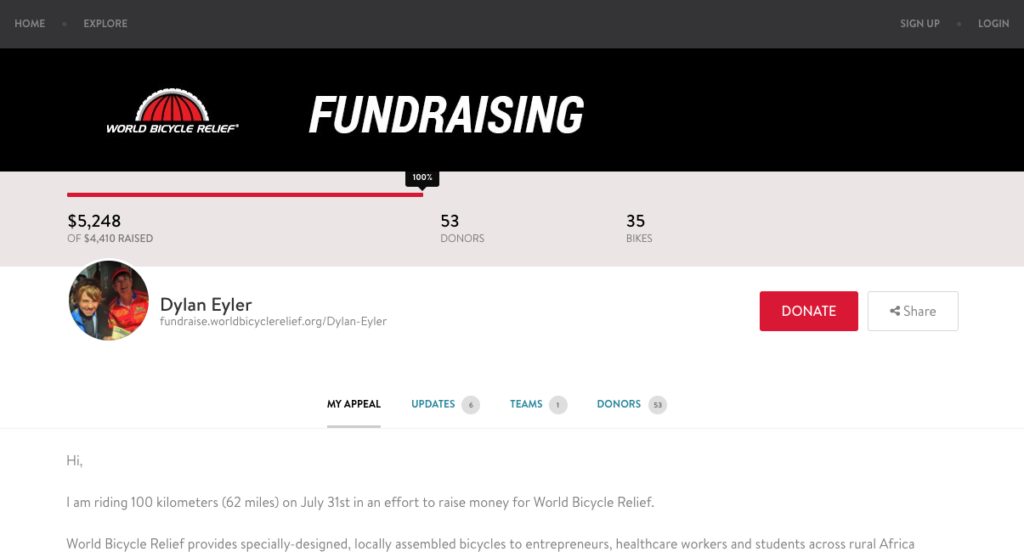
Are You Ready To Run Your Peer-To-Peer Fundraising Campaign?
At CauseVox, we’re ready to help you with every aspect of your campaign. Want a closer look at how you can set up your peer-to-peer fundraising campaign? Sign up for a 1-1 walkthrough of the platform. Ready to jump right in? You can sign up for your account for free-there’s no setup fee!




